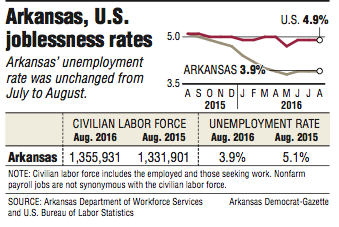Arkansas' unemployment rate remained unchanged at 3.9 percent in August, the fifth straight month it has been below 4 percent, the U.S. Bureau of Labor Statistics said Tuesday.
The national unemployment rate was 4.9 percent in August.
Arkansas' unemployment rate has declined at a faster pace than the nation's in the past year, said Susan Price, a spokesman for the Arkansas Department of Workforce Services. The state and national unemployment rate in August last year was 5.1 percent.
Arkansas' 3.9 percent unemployment rate is tied for the 10th lowest in the country with Massachusetts and Virginia.
Arkansas was tied with Tennessee for the largest decrease in the unemployment rate since August last year, at 1.2 percentage points each, the Bureau of Labor Statistics said.
"The unemployment rate seems to have stabilized pretty firmly at 3.9 percent," said Michael Pakko, chief economist at the Institute for Economic Advancement at the University of Arkansas at Little Rock.
Since April, the state's unemployment rate has been at 3.9 percent every month except for May, when it was 3.8 percent.
"The point is Arkansas has made considerable progress over the past year," Pakko said. "But if you look carefully at the month-to-month changes, things have slowed down in later spring and summer of this year. We're still moving in the right direction, just at a bit of a slower pace."
The low, steady unemployment rate may be the best Arkansas can expect, said Kathy Deck, director of the Center for Business and Economic Research at the University of Arkansas at Fayetteville.
The reason, Deck said, is because "we're so close to full employment in this state."
Full employment "is a dynamic situation," Deck said.
"It's not as if [full employment] is a fixed amount and we can't go past that," Deck said. "Our unemployment rate for the state is lower than we would have thought that we could sustain over a long time period."
If enough jobs are created in Arkansas, people will start to move here, Deck said.
"And that would keep our unemployment rate relatively steady," she said. "People who have been out of the labor force will either come back because it's very attractive or [people] will physically move [to Arkansas for jobs]."
The number of Arkansans in the labor force grew by about 24,000 to almost 1.4 million since August 2015. Over the same period, the number of employed Arkansans was up by about 38,350 to slightly more than 1.3 million.
"The fact that the labor force grew and employment grew while the unemployment rate remained so very low is great news," Deck said.
Eight job sectors recorded job increases in August and three lost jobs.
The biggest gain was in the professional and business services sector, which added 7,600 jobs. The sector includes such high-paying jobs as lawyers, attorneys and architects as well as some lower paying administrative support jobs.
Arkansas' trade, transportation and utilities sector -- the state's largest sector, with 256,800 jobs -- is also among the largest sectors in the country as a percentage of states' overall jobs, said Greg Kaza, executive director of the Arkansas Policy Foundation in Little Rock.
The sector includes wholesale and retail trade, transportation, warehousing and utilities.
The sector, which added 3,400 jobs in August, accounts for 20.9 percent of Arkansas' jobs, the fifth highest percentage nationally. North Dakota is first with 21.8 percent of its jobs in the trade, transportation and utilities sector.
Another factor is that Wal-Mart is based in Arkansas. Many of those Wal-Mart jobs in Bentonville are in other sectors, such as the professional and business services sector, Kaza said.
But the wholesale trade sector that is attracted to Northwest Arkansas because of Wal-Mart is another factor, Deck said. And another reason for the size of the trade, transportation and utilities sector is the prominence of trucking companies in the state, Deck said.
The sector is very broad, Kaza said.
Under retail trade, it includes motor vehicle and parts dealers, which is one of the faster-growing categories in the main sector, Kaza said. Another fast-growing category is truck transportation, warehousing and storage, Kaza said.
Nationally, South Dakota had the lowest unemployment rate, at 2.9 percent; followed by New Hampshire; at 3.0 percent; North Dakota, at 3.1 percent; Nebraska ,at 3.2 percent; and Vermont, at 3.3 percent.
Alaska had the highest unemployment rate in August, at 6.8 percent; followed by New Mexico, at 6.6 percent; Nevada and Louisiana, at 6.3 percent each; and Mississippi, at 6.0 percent.
Business on 09/21/2016

